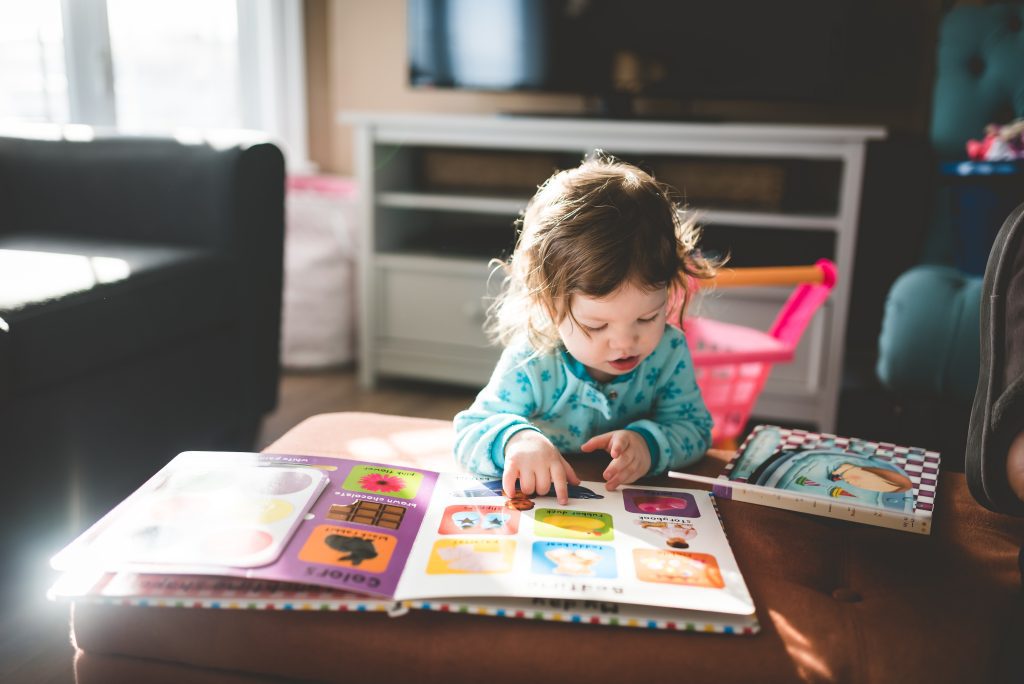Melanie Wegener
As a primary school teacher, I am passionate about seeing children develop in their literacy skills in the early years. It was shocking to me how many children would arrive at school not knowing the right way to hold up a book, or how to turn pages carefully. Some struggled to pick out basic rhymes. Others lacked the ability to sit down and concentrate when being read to.
I desperately wished that more parents knew both how important early literacy was and also how much easier it would make their schooling life.
Now that I am a parent, I am aware of the reality of exhaustion and lack of time. I get that finding space to read before bed can be tricky. However, it can be done and it’s not as hard as you might think.
Here are ten ways to develop early literacy with your child:
1. Display books everywhere
It is important to have books displayed in different areas around the house. Have some on the change table so your baby or toddler can see when he lies down. Begin with simple black and white pattern ones and gradually progress to board books, touch and feel books and then picture books. Have them in their bedroom, playroom and lounge. Many stores sell low bookshelves that allow the front cover to be displayed allowing for children to browse them more easily than looking at the spine.
Have some bath books for them to read with you in the water. Look at cookbooks together and find recipes to make, especially from children’s versions. Browse the newspaper and look at the comics. Let them circle and cut out items from catalogues, and stick them into a scrapbook. Ask them what they would like to put on their present list. Write letters and postcards to friends and family and read the responses together. Look at real estate guides and compare the different houses that are for sale. Demonstrate that reading is important to our daily life and include them in the many different texts we come across each day to read. Provide as many opportunities as you can.

2. Visit the library
Let them browse the shelves and not be rushed where possible. Borrow a range of books – ones with a special theme, picture books, readers, comics, rhyming books, books with only illustrations, big books, non fiction and search and find. Make it fun by only borrowing books by authors starting with an ‘A’, and next time find the ‘B’ ones, then the ‘C’s etc. Borrow a CD and show them how to read the list of tracks on the back, and the words to the songs inside the cover.
Most libraries offer song or story time for babies, toddlers and preschoolers. This is a valuable time of fun, laughter and learning. Children learn through rhyme and repetition, and can often use puppets. They follow along with actions and clap in time. They memorise nursery rhymes and songs which helps them develop language, much of it will stay with them forever. Children have the chance to socialise with one another and how to get along. They enjoy cuddles with their big people and can sit down on the mat independently when they are ready.
Some libraries allow you to borrow toys. You can help choose some items that challenge your children and develop their literacy. There are often book packs with activities ready to go, as well as many games and resources. This saves you money and reduces what you have to store and organise yourself, while rotating items helps to keep things interesting.
3. Keep books in your car
Keep a few books in your car. These can be in place of electronics while they are waiting for you to finish packing the car, to read while you drive (unless they get carsick) and to take into appointments. We use the street directory, sticker books, activity books and picture books. I keep some pens and textas handy for them to use too.
Sometimes I’ve had to resort to an iPad or phone if appointments go for too long, or to distract a toddler while I’m feeding, but it’s not my go to. I try to see it as bonus literacy time. We can read together, complete activities and practice writing. With the street directory, my preschooler likes looking for parks, the beach, road names and the compass. He finds the street he lives on and follows a path with his finger to places nearby.

4. Play with letters
Have toy versions of alphabet letters they can build into words. Provide opportunities for playing with letters. These can be foam ones for the bath, magnetic ones for the fridge and even duplo style ones. You can buy cheap phonics cards that spell words or build simple three letter puzzles. Focus on the play and practice rather than correct spelling.
Children can practice forming letters in sand (in a sandpit or sensory box) or with playdough. They can use activity books and practice tracing letters I find textas and pens can be easier to use than pencils for some children. They can paint with watercolours or use crayons. The more young children have chances to play with letters, the more they will begin experimenting with reading, spelling and writing.
5. Read books aloud
Make time to read to your child every day. When reading aloud, leave off the last word in a sentence or line for them to fill in. Children love reading the same books over and over again, and like to master the text. Even toddlers remember familiar words and have great satisfaction filling in the blank.
Read at least one rhyming story each day. Emphasise the rhymes. Pause at the end of the line for your child to fill in the gap. Highlight the words that rhyme and point to where they are. Ask them to come up with other words that rhyme with it. Mem Fox has some wonderful suggestions in her book Reading Magic.
6. Be intentional
Take time to read the book carefully together and notice different things. Use different character voices and point out the speech marks. Show what happens to your voice when there is an exclamation point or question mark at the end of a sentence. Demonstrate the change in volume when all capitals are used.
Point out the author and illustrators name, and ask what each person does. Read the blurb together. Talk about what a dust jacket and a spine is. Ask if it is a fiction or non fiction text. Look at the front cover and make predictions about what the book will be about. As you go along, ask what you think might happen. At the end, think about what the moral of the story might be, or why the author decided to write it.
Ask them to find different items on each page, and then give them a go. Can you point to the letterbox? Where is the yellow duckling? Question how the character might be feeling. Make connections to everyday life by asking if they ever feel sad too. Put your finger under the words so they can follow along.

7. Storytell
Storytelling isn’t my strong suit but my boys love when I tell them stories. It can be retelling the familiar ‘Goldilocks and the Three Bears.’ It could be telling them the story of how mummy and daddy met or about when they were little. It could be a made up one. It doesn’t need to be perfect! Your child will simply love snuggling up next to you, listening to your voice and imagining the story in their minds.
8. Make screen time count
I don’t advocate much screen time but it can be a valuable teaching tool. Reading Eggs is a fabulous program to help young children learn to read. It is suitable for ages 2-13. You can sign up for a 30 day free trial here.
Often teachers in the early years of school use short videos to help children remember important things. Our eldest at two learnt his letters and sounds simply by watching 2 videos every day (under 10 minutes) for a month we were on holidays. If you search for phonics song and jolly phonics’ it will come up with a few versions.
They are simple and repetitive, and very helpful for young children. These videos can also be listened to on a speaker or in the car so they aren’t watching another show. I also recommend the alphabet song, days of the week, months of the year, seasons song. Nursery rhymes are always a wonderful choice for young children too.
9. Develop oral language
Talking with your children helps to develop their oral language skills. It’s so easy to be distracted with our phones or other technology, but our children really do need our full attention. Take an interest in what they do. Talk to them as you walk and point out things that you can see. Chat in the car and explain what the different signs are, the road rules and emergency vehicles driving past. When someone irritates me with their driving, I talk through how I’m feeling about it.
When you’re eating dinner, try to sit at the table together. This is a wonderful time to talk about what happened in the day, who they played with, ask what their favourite part was, something that was hard, and what they’re looking forward to. Cook together and chat as you work through the recipe. There are lots of small opportunities throughout the day to talk and observe, and not only will this help their oral language skills and then their written ability, it will build your relationship.
10. Model reading yourself
Children watch what we do more than they listen to us. Keep a book or magazine on the coffee or dining table. Depending on your stage of life, read the newspaper over breakfast, or a chapter of your book with your lunch. Try to model using a paper version of a book rather than electronic so it is obvious what you are doing, even if it is purely for daylight hours.
Borrow books and magazines for yourself when you visit the library. Take them on holiday. Make a cubby and each bring some books to read as you snuggle up with blankets. Request books for your gift ideas. Browse for new ones together at op shops. Having a passion for reading yourself is one of the easiest ways to encourage your child to love reading too.

There are many simple things we can do to develop literacy in young children. Try to make the most of the time that you spend with them, even if seems like monotonous driving or doing chores. Children will enjoy playing and learning with you. The more their literacy skills develop, so will their confidence.
















3 Responses